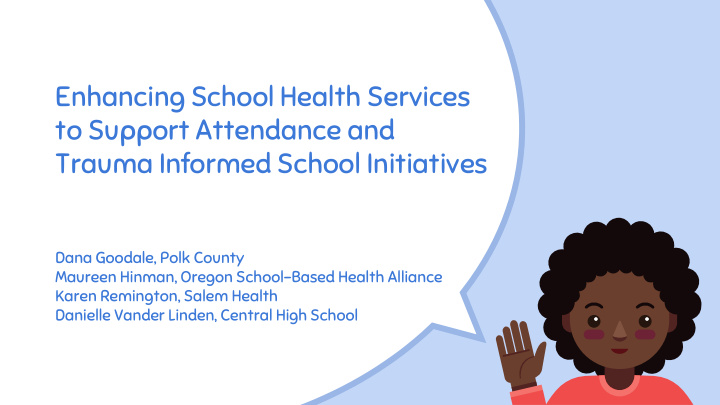



Enhancing School Health Services to Support Attendance and Trauma Informed School Initiatives Dana Goodale, Polk County Maureen Hinman, Oregon School-Based Health Alliance Karen Remington, Salem Health Danielle Vander Linden, Central High School
2 Objectives ➢ Describe a model of cross-sectoral collaboration to address health related barriers to attendance. ➢ Discuss different data sources used to identify student health issues. ➢ Identify at least two potential interventions used to support students in building resilience.
3 Background
4
5 School-Based Health Center ★ Central Health & Wellness Center staff ★ School district administration support of student access; opt-out registration ★ Youth Advisory Council co-chairs: SBHC coordinator/high school assistant principal ★ Quarterly Oversight Council meetings
6 School-Based Mental Health ★ Long standing partnership ★ All students have access to mental health support ★ Addressing all barriers to education ○ Anxiety, Depression, Grief & Loss
7 Trauma Informed Schools Grant ★ School unites two towns ★ Safe, welcoming environment for students, staff and community ★ Staff professional development ★ Community collaboration ★ PBIS tier 1 focus ★ Culture/climate
8 OSBHA ★ Works to strengthen school-based health services and systems ★ SBHC expertise ★ Youth development/engagement ★ Provides technical assistance on the trauma informed schools grant
9 Central Community Collaborative Kaiser Grant Goals - Reduce chronic absenteeism and in-school discipline and address racial, cultural and ethnic disparities in health and education. Our Work ➢ Build on Tier 1 trauma informed schools work ➢ Community Collaboration to develop Tier 2 system of services
10 Partnership/Cooperation vs Collaboration Mutual Respect Mutual Trust Transparency Vulnerability Shared Goals Shared Values Independent Interdependent Sharing of Ideas Generating New Ideas Together Collaboration = deeper work, more innovation, better quality
The Process 11
12
13 Our Long-Term Vision A common understanding, language, process, and tools to create a continuum of student support services.
14 Laying the Groundwork Build Com Common La Language Examine Data Chronic Absenteeism Oregon Healthy Teens Multi Tiered System of County Youth Data Support SBHC and school mental Trauma Informed health utilization Resilience School absence and behavior referral data
15 School-Based Mental Health School-Based Health Center
16
17 Documenting the System
18
19 Developing and Testing Interventions ★ Attendance campaign ★ Warm handoffs, etc ★ SBHC student appointment slots around lunch hour and after school
20 Focus and Next Steps
21 SBHC Plans ★ ACE’s/Resiliency training ★ QPR Suicide Prevention training ★ Partner with school around trauma informed care ★ Scheduling opportunities ★ Solicit YAC feedback
22 SBMH ★ Continue partnership with SBMH and Behavioral Health regarding suicide screening ★ Exploring a shift from Tier 3 to Tier 2 focus
23 School ★ Care Team ★ Wellness Room ★ Continued Attendance Team Development ★ Continued Tier 1 Trauma Informed Implementation ★ Continued Professional Development
24 Key Components/Concepts ★ Trauma informed care: Changing thought processes, relationships, interactions ★ Multi-Tiered System of Support (PBIS) ★ Ease of access to services for students in all arenas ★ Communication! ★ ACEs Screening, Wellness Room, Care Team will all inform us about root causes and appropriate Tier 2 interventions moving forward ★ Eventually, students and/or caregivers
25 Panel Q&A
Thanks! 26 Follow up questions? You can find us at ★ goodale.dana@co.polk.or.us ★ maureen@osbha.org ★ karen.remington@salemhealth.org ★ dvanderlinden@central.k12.or.us
Recommend
More recommend